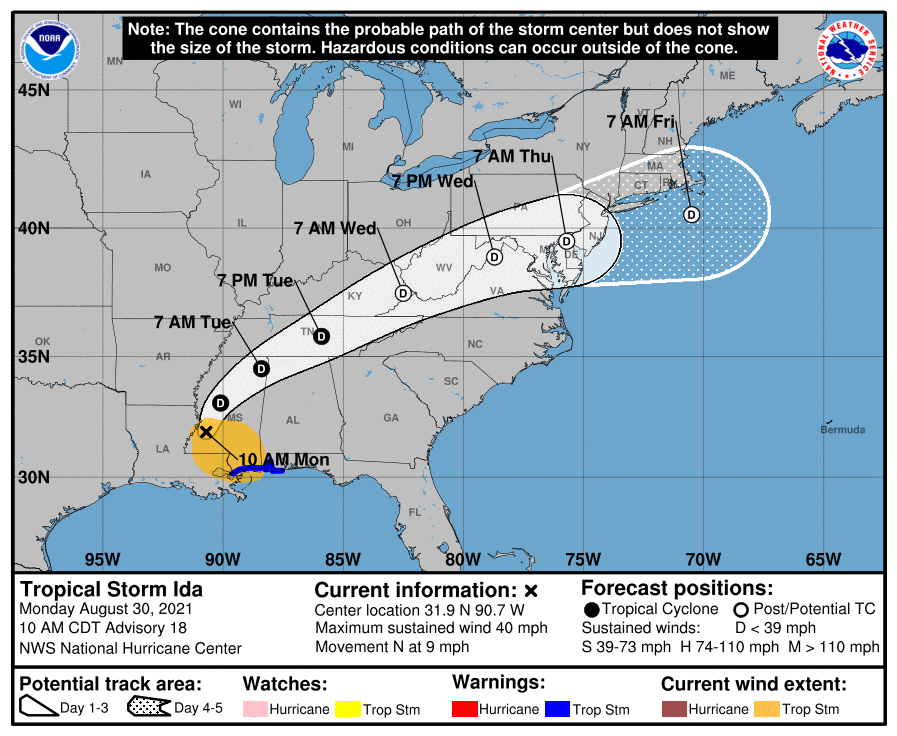Ida Weakens Over Mississippi After Ravaging Louisiana
Aug 30, 2021
Hurricane Ida was downgraded to a tropical storm over Mississippi on Monday after ravaging Louisiana as Category4 hurricane. The storm made landfall on Sunday, August 29th, 16 years to the day that Hurricane Katrina walloped the state. Katrina was blamed for 1,800 deaths as it caused levees to fail that resulted in catastrophic flooding in New Orleans.
The Crescent City lost all power at about sunset on Sunday, leading to a scary night that included torrential rain and howling winds. The worst of it finally faded shortly before dawn and people began to cautiously walk their neighborhoods with flashlights as they dodged downed light poles, pieces of roofs and branches.
Levees were topped south of the city threatening hundreds of homes. Residents used social media to post their addresses and locations as direction for searchers and rescue teams. Authorities promised to start the massive rescue effort as the weather broke and the sun rose.
The storm was delivering winds of up to 150 mph when it made landfall, which tied it for the fifth strongest hurricane to ever strike the mainland.
Ida dumped rain onto Mississippi as it slowly moved north. More than a million customers in Louisiana and Mississippi were without power, according to PowerOutage.us.
Businesses including the New Orleans Office of Homeland Security & Emergency Preparedness had power because they were equipped with standalone generators. The city still relied on emergency power from Entergy, an electric utility, to provide backup power for pumps to throw storm water over the city’s levees. The 911 system experienced technical problems in Orleans Parish early Monday.
Ida was designated a tropical storm about 16 hours after making landfall. Top sustained winds were 60 mph early Monday, and it was expected to continue pummeling rain over a large area.
The storm surge swamped Grand Isle as Ida made landfall. It threated more than 2 million people who inhabit the area around and in New Orleans and Baton Rouge.
The storm intensified into an extremely powerful hurricane so quickly over the Gulf of Mexico, there wasn’t enough time to call for a mandatory evacuation of about 390,000 residents.
Louisiana Governor John Bel Edwards told the media that rescue crews would not be able to immediately assist people who were stranded. He warned that it might take the state weeks to recover.
The storm surge generated by Ida from the Gulf inland caused a “negative flow” of water on the Mississippi River, according to the U.S. Army Corp of Engineers.
Ida trudged through one of the nation’s largest industrial corridors, which hosts a plethora of petrochemical sites. The Louisiana Department of Environmental Quality was in contact with more than 1,500 oil refineries, chemical plants, and other sensitive facilities and said that it would respond to any pollution leaks or spillage.
One man died and there were catastrophic damage in sections of southeast Louisiana on Sunday night, according to federal authorities. A levee failure was reported in Jefferson Parish, which threatened 200 people.
All flights were canceled at Louis Armstrong New Orleans International Airport.
The storm comes when Louisiana was contending with a major COVID-19 spike. Hospitals in New Orleans were experiencing a “severe outbreak” of Covid. There has been a seven day average of 220 new infections, according to the City’s Covid-19 dashboard. More than 3,400 new cases were confirmed as of Friday, according to the state Health Department. At least 2,684 people were hospitalized with Covid in the state.
The entire city of New Orleans was without power due to all major transmission lines being knocked off the power grid. It created a load imbalance that knocked all power generation in the region offline.
Many expected that about 1 million homes along the Gulf Coast might be damaged or destroyed by Hurricane Ida.
Hurricane Ida is the ninth named storm of the 2021 hurricane season, the fourth hurricane, and the first projected major hurricane expected to reach a Category 4 storm, the second strongest possible storm.
As of 10:49 a.m. eastern time on Monday, August 30, top areas of outages due to Ida were:
- Louisiana 1,036,201
- Mississippi 127,362
- Alabama 5,106
- Tennessee 2,313
- Arkansas 1,269
(Source: poweroutages.us)
Severe weather that causes massive power outages seems to be a regular event as the earth is threatened with global warming. Be prepared for the worst with your own standby generator. APElectric has a large inventory of generators made by some of the most popular brands in the U.S. Review our website for information on all the generators we have to offer and review more information that assists you in selecting the proper generator for your situation.
For full forecast visit https://www.nhc.noaa.gov/
